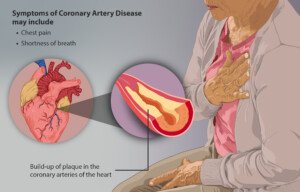
If every time you go for a walk you feel pain between your shoulders, this actually could be a sign of heart trouble, namely angina.
In fact, the odds of this being a musculoskeletal problem aren’t particularly high, since soft tissue or joint problems that cause pain between the shoulders would be triggered by different activities and movements, not just merely walking.
This would be especially true if your brisk walks don’t involve a hardy arm pump that may conceivably strain deconditioned upper back muscles.
Angina is highly suspect if:
- Other movements that involve retraction or pulling back of the upper back muscles don’t cause pain.
- The pain is predictable when you go on fast walks – especially if it is between the shoulders and kicks in almost immediately.
If the pain between your shoulders tends to dissipate as the walk goes on (even at a quicker pace), this doesn’t mean it can’t possibly be heart related.
Angina usually subsides when the physical exertion ceases. But there are cases in which it subsides with continuation of the activity.
This doesn’t mean you’re in safe territory. If you have angina, even if it vanishes as the walking or other activity continues, you STILL have blocked coronary arteries! You can’t ignore this!
Angina Can Cause Pain Where You Least Suspect It
“Angina can absolutely cause pain between the shoulders when someone is walking briskly or doing any kind of similar physical activities,” says Charles C. Cummings, MD, Interventional Cardiologist, LifeBridge Health Cardiovascular Institute in Baltimore, MD.
“This would be considered an atypical symptom because people do not usually associate this type of pain with having angina.
“Typical symptoms of angina involve a squeezing pain or pressure in the chest that radiates to the left arm and shoulder or jaw.
“In general, atypical pain is most often experienced by women and people with diabetes, but men may also experience it.”
The pain between your shoulders while walking fast or even slower, that disappears soon after or once the walking ceases, is suspect for angina ALSO if any of the following applies to you:
• Overweight
• Smoker
• Junk food diet
• Poor sleep habits
• High blood pressure
• Diabetes
• Chest pain with exertion
• Feeling more fatigued lately without explanation
• Strong family history of heart disease
• Age: men over 45; women over 50
These are risk factors for heart disease. Exertional angina occurs when there’s not enough blood flowing through the heart due to clogged coronary arteries.

myupchar. com
Another risk factor for coronary artery disease is a lifelong absence of at least moderate effort aerobic exercise.
Or, to put that another way, you’re a “newbie” when it comes to structured cardio exercise.
Even a neighborhood walk can trigger angina in those with bad-enough coronary heart disease.
The absence of chest discomfort does not exclude angina as the cause of pain between the shoulders.

Dr. Cummings holds several cardiovascular device patents and is board certified in internal medicine.
 Lorra Garrick has been covering medical, fitness and cybersecurity topics for many years, having written thousands of articles for print magazines and websites, including as a ghostwriter. She’s also a former ACE-certified personal trainer.
Lorra Garrick has been covering medical, fitness and cybersecurity topics for many years, having written thousands of articles for print magazines and websites, including as a ghostwriter. She’s also a former ACE-certified personal trainer.
.









































